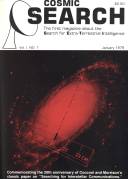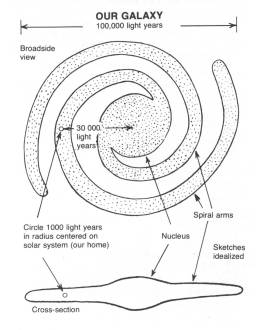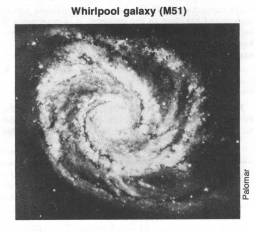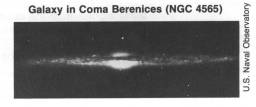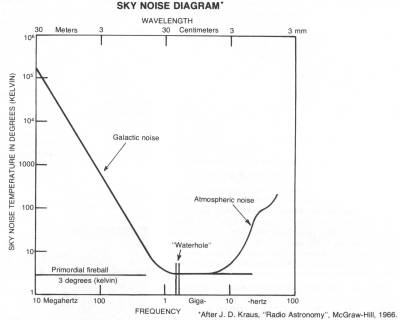![[NAAPO Logo]](../../Images/NAAPOsm.jpg) North American AstroPhysical Observatory (NAAPO)
|
|
ABCs of SETI
By: John Kraus
A The Galactic Perspective.
We (that is the sun, the earth and the sun's other planets) are situated in a spiral arm some 30,000 light years from the center of the galaxy or about two-thirds of the way from the center to the edge — in the galactic boondocks or outback. The little circle at our location in the two sketches has a radius of 1000 light years. Within a sphere of this size there are about one million stars. A sphere of 1000 light year radius is really enormous yet it constitutes less than one-hundredth of one percent of our galaxy! And beyond our galaxy are some 100,000 million more galaxies.
Summary:
B The Cosmic Perspective.Our universe began to form about 15,000 million years ago with the explosion of a primorial [sic; primordial] fireball (The Big Bang). The Cosmic Calendar lists events that have occurred since that time. We note that our advanced technology (even mankind for that matter!) has only been around for a very short time. It is apparent that we are a very young, emerging civilization. Light, radio or other electromagnetic waves travel 300,000 kilometers per second in empty space. This is the top speed at which anything can travel. We can express astronomical distances using this velocity. See Distance Table. Thus, the distance to the moon in light travel time is about one second, to the nearest star (other than the sun) about 4 years and to the limit of our universe about 15,000 million years. The waves (light or radio) from some galaxy 2 million light years distant (same as 2 million years light-travel time) are 2 million years old when they get here. This means we see or observe the galaxy as it was 2 million years ago. Like cosmic archeologists, we are looking back in time 2 million years. The farther out we look the farther back in time we see. Thus, in a very real sense time and distance are closely inter-related.
C Numbers and the SETI Probability Game.
How likely is it that there are other civilizations in our galaxy capable of communication? If you consider all of the factors you can write a simple relation, as done by Frank Drake, for estimating the probability. I use the word "estimate" intentionally because our knowledge of most of the factors is so poor that we are really only guessing. Your guesses may be as good (or bad) as the next person's so why not play the probability game and see what number you come up with?
The relation, known as Drake's Equation, involves 7 factors as follows:
Suppose you guessed that stars in our galaxy form at the rate of one per year (probably not a bad estimate), that 1/5 of the stars have planets (no one knows), that there are 2 planets with stable environments (a guess), that life appears on each (fraction = 1), that intelligence emerges on each of these (fraction = 1), that 1/10 of these develop communication capability and that these remain in this state for 1000 years. Then, it works out that the number is 40 (as above).
According to this estimate, there would be 40 civilizations in our galaxy capable of communication, or about one per trillion (1012 or ten to the twelfth power) cubic light years so that the nearest one might be something like 10,000 light years away.
However, if it is in a communicative mode for only 1000 years, as assumed, it will be extinct long before its signals are received at the earth. The longevity time (last factor) is very uncertain. Is it 10 years or one million? In this example we have assumed 1000 years.
Now, you play the SETI game by writing down your numbers. Who knows? Your result may be the right one.
Summary:
D The Wavelength Picture.Even if we believe that there may be other civilizations, in which direction should we look and, if we use radio, on what wavelength (or frequency) should we listen? Let us answer the last part of this question now, leaving the rest for a later issue.
There is also natural emission from the hydroxyl (OH) radical at 18 centimeters. Now if you combine hydrogen (H) with the hydroxyl radical (OH) you get water (H2O), so the wavelength region between 18 and 21 centimeters is often referred to as the "waterhole", in further allusion to the fact that galactic civilizations might (like radio amateurs) gather around this "waterhole" to chat like different species of animals gather around an African waterhole to drink.
Summary:
Notes:
Waterhole wavelengths:
In the next issue of COSMIC SEARCH the above topics will be pursued further and other facets of SETI will be considered. Many books for further reading are listed in "Off the Shelf" (elsewhere in this issue). The ones by Drake, Sagan, and Sullivan are good as an introduction.
|
